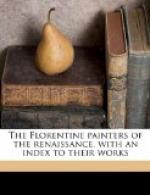For a hundred years after Giotto there appeared in Florence no painter equally endowed with dominion over the significant. His immediate followers so little understood the essence of his power that some thought it resided in his massive types, others in the swiftness of his line, and still others in his light colour, and it never occurred to any of them that the massive form without its material significance, its tactile values, is a shapeless sack, that the line which is not functional is mere calligraphy, and that light colour by itself can at the best spot a surface prettily. The better of them felt their inferiority, but knew no remedy, and all worked busily, copying and distorting Giotto, until they and the public were heartily tired. A change at all costs became necessary, and it was very simple when it came. “Why grope about for the significant, when the obvious is at hand? Let me paint the obvious; the obvious always pleases,” said some clever innovator. So he painted the obvious,—pretty clothes, pretty faces, and trivial action, with the results foreseen: he pleased then, and he pleases still. Crowds still flock to the Spanish chapel in S. Maria Novella to celebrate the triumph of the obvious, and non-significant. Pretty faces, pretty colour, pretty clothes, and trivial action! Is there a single figure in the fresco representing the “Triumph of St. Thomas” which incarnates the idea it symbolises, which, without its labelling instrument, would convey any meaning whatever? One pretty woman holds a globe and sword, and I am required to feel the majesty of empire; another has painted over her pretty clothes a bow and arrow, which are supposed to rouse me to a sense of the terrors of war; a third has an organ on what was intended to be her knee, and the sight of this instrument must suffice to put me into the ecstasies of heavenly music; still another pretty lady has her arm akimbo, and if you want to know what edification she can bring, you must read her scroll. Below these pretty women sit a number of men looking as worthy as clothes and beards can make them; one highly dignified old gentleman gazes with all his heart and all his soul at—the point of his quill. The same lack of significance, the same obviousness characterise the fresco representing the “Church Militant and Triumphant.” What more obvious symbol for the Church than a church? what more significant of St. Dominic than the refuted Paynim philosopher who (with a movement, by the way, as obvious as it is clever) tears out a leaf from his own book? And I have touched only on the value of these frescoes as allegories. Not to speak of the emptiness of the one and the confusion of the other, as compositions, there is not a figure in either which has tactile values,—that is to say, artistic existence.
While I do not mean to imply that painting between Giotto and Masaccio existed in vain—on the contrary, considerable progress was made in the direction of landscape, perspective, and facial expression,—it is true that, excepting the works of two men, no masterpieces of art were produced. These two, one coming in the middle of the period we have been dwelling upon, and the other just at its close, were Andrea Orcagna and Fra Angelico.




